Sam Raimi’s Oz: The Great and Powerful may be this summer’s first blockbuster effects film, but several of its characters and environments looked to some very practical means for reference. We go behind the scenes with the filmmakers and VFX artists to learn how they crafted the porcelain China Girl based an on-set marionette performance, bringing the monkey Finley to life and widening Oz’s vistas. UPDATED with before and after imagery and Luma Pictures’ work for the tornado sequence.
The film is based on L. Frank Baum’s Oz novels, acting as somewhat of a prequel to the 1939 classic The Wizard of Oz, itself a landmark effects film through the use of innovative matte paintings and rear projection techniques. Raimi’s Oz saw Sony Pictures Imageworks take on the lion’s share of the shots – more than 1,100 – led by overall visual effects supervisor Scott Stokdyk. The film was lensed by Peter Deming in native stereo on RED EPICs with the 3ality Technica rig. Production design was handled by Richard Stromberg and special effects by John Frazier.
Listen to our fxpodcast on Oz, where Mike Seymour discusses the characters of China Girl and Finley with Imageworks visual effects supervisor Scott Stokdyk, digital effects supervisor Francisco DeJesus and puppeteer Phillip Huber.
China Girl
In the film, traveling magician Oscar ‘Oz’ Diggs (James Franco) is transported to the Land of Oz thanks to a tornado. Here he meets all manner of witches, creatures and characters – including China Girl. She is a porcelain doll whose village and family have been destroyed by the Wicked Witch.
In order to bring China Girl to life, Raimi wanted to ensure the actors, particularly Franco, had a tactile character to interact with during filming. The answer lie in Phillip Huber, a master puppeteer whose previous work included the incredibly life-like marionettes in Being John Malkovich, and having the voice of China Girl (Joey King) perform the lines on set in a sound proof booth – with the performers mic’d up. Imageworks would then take the puppet reference and craft China Girl as a digital character.
“We had Phillip on set in a blue suit,” explains Stokdyk. “He was puppeteering in real time as the China Girl with James Franco. At the same time we had Joey playing China Girl in a sound proof booth right next to the set. James had an ear wig in his ear so Joey and James could have conversations. Interestingly, everyone was so impressed with the movement of the marionette, even though all it could do was move a few limbs and blink its eyes. Phillip was really able to capture an amazing performance even with those limitations.”
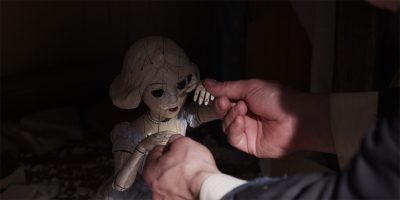
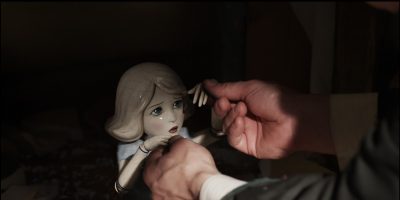
Prior to filming, KNB EFX – responsible for much of the film’s make-up and prosthetic effects – constructed a China Girl macquette. This was sent to Huber in cut-up sections so that he could piece it together with the necessary joints for performance. Two marionettes were made, with 20 and 21 strings, one with long strands and the other short depending on the position Huber needed to be in to manipulate the doll. A special control bar was used for the eyes, and, after early consideration of a fully porcelain dress showed there would be too much restricted movement, the clothing for China Girl remained cloth.
On set, Huber wore a blue suit that would aid in keying him out of scenes, and he wore an earwig to hear King and the other actors. He told fxguide the performance involved all the nuances of a human being. “I’m taking an inanimate object and giving it the illusion of life,” says Huber. “That includes breath, thinking, feeling. I wanted all of those qualities in China Girl – she would stop to breathe, stop to think. I was riding on the performance Joey King would give vocally. And she was following any little pause or flinch as well. I also took her vocal cues of excitement or sadness or whatever and translating that to the body language of the marionette.”
– Watch a short clip of Phillip Huber and the China Girl marionette, in cooperation with our partners at Fairfax Media.
For shots of Oz holding China Girl, Imageworks faced roto and animation that went from “hard to harder to almost impossible,” recalls digital effects supervisor Francisco DeJesus. “They would shoot many many takes – always a rehearsal, some with the marionette – and then after having done a few Sam, would do a few clean takes with James Franco miming the performance holding nothing but air.”
Imageworks animation supervisor Troy Saliba and his team then followed Huber’s performance as closely as possible, often embracing the restrictions that a stringed puppet presented. “They tried to limit internal movement on the face as much as possible, particularly the eyebrows,” notes Stokdyk. “The way he got around that, beside the same things Phillip had done with the marionette, was to hide expression changes either on cuts or within head turns or just really balance trying to be subtle about them.”
Finley the flying monkey
Although the flying monkey Finley (Zach Braff) – another character Oz encounters in the Land of Oz – was also a digital creation, there was less reliance on a stand-in of the kind used for China Girl. Instead, Braff would perform lines on set. “When we couldn’t have Zach on set,” comments Stokdyk, “instead of the classic tennis ball on a stick, we ended up doing – I called it puppet cam – but it was really as simple as a monitor and a camera on a stick. We set up a two way video conference that was puppetteered. So if the monkey was flying from a tree stump up to in front of James’ faces, we would actually have a puppeteer with a blue rod and a monitor attached to it, which was a direct feed to Zach in a booth off set – Zach was seeing the video feed from a camera attached to that scene.”
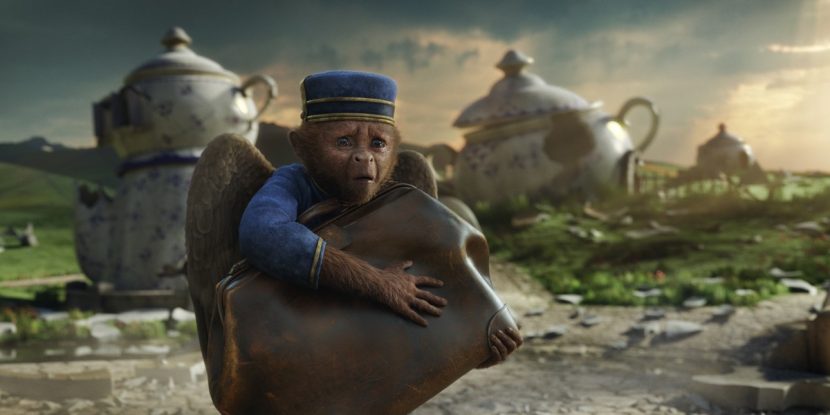
“It was really beneficial to get that same face to face performance,” continues Stokdyk. “All the artistic decisions about what the monkey was doing are driven mostly from the interaction between James and Zach on set – Zach would do this incredible amount of improv, and they would have this dialogue, and Troy and his animation team would go back and try to figure out what body movements and what wing movements would accommodate that.”
Finley follows Oz down the yellow brick road.Finley’s wings were mostly based on traditional birds, and were posed subtly to match his dialogue. (The baboons, on the other hand – sent to do the Wicked Witch’s begging – had much more leathery wings inspired by bats, with Imageworks also taking into account their extra wing to mass ratio which made them somewhat less maneuverable.)
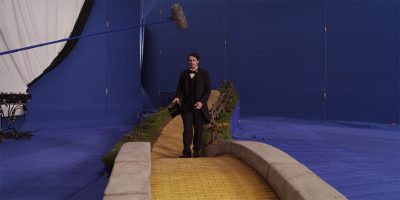
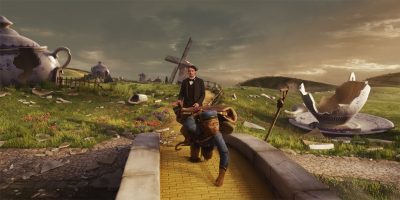
Environments and effects
The Land of Oz is filled with stunning plant life, creatures and of course locations such as Emerald City. Several stages were utilized in Detroit for filming, with Imageworks and other vendors enhancing Oz’s environments. Production designer Robert Stromberg played a key role in defining the visual effects work. “After they had shot something,” explains DeJesus, “Robert would take a still image from the main camera and replace the bluescreen and paint over it and give it to us as a reference.”
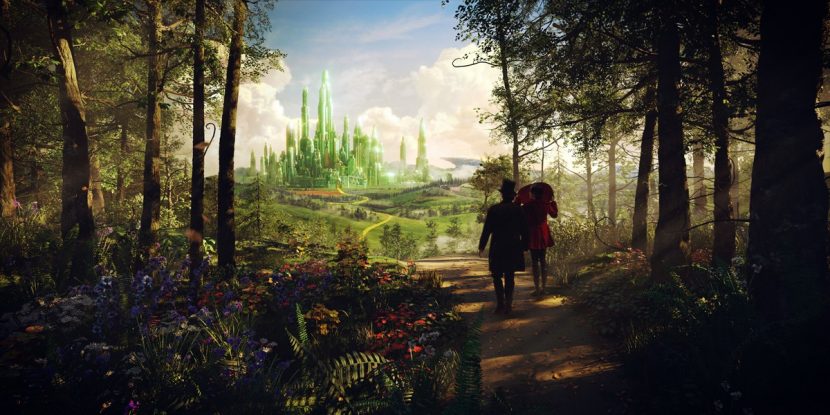
Just some of the environments created by Imageworks included panoramas of Oz, the gorge and river, Emerald City, China Town, Haunted Forest, the bubble ride, Glinda’s castle and village and the poppy fields. The film was also a huge effects effort for shots such as witch magic, the bubbles, a shimmering wall around Glinda’s countryside and village, Theodora’s fire tornado, Glinda’s impenetrable mist, Oz’s hologram and destruction of the balloon during the hologram show.
Watch the balloon ride through the Land of Oz.As they had done for China Girl and many other creatures and environments, Sony relied on HDRs using a dual Spheron camera setup. The pipeline was then Maya for animation of the many creatures, characters and digi-doubles, Houdini mainly for effects (although Naiad was also used in the rapids sequence), Katana for lighting, Arnold for rendering and compositing in Nuke.
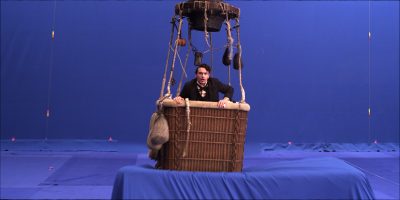
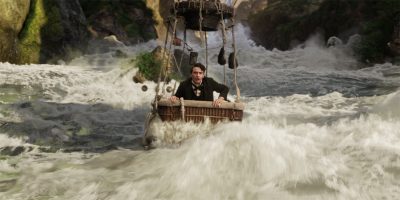
Certainly, while much of the photography took place on sets and against bluescreen, Stokdyk notes that “early on we decided we wanted to have more of a classic old-school Hollywood feel for the film. So we wanted to build as many sets as we could.” Interestingly, bluescreen was chosen as the main chroma background – partly since several characters and settings were green, and partly for comfort. “Doing a 100 day shoot on greenscreen – because your eyes are so sensitive to green – it’s so hard, it’ll drive you crazy,” suggests Stokdyk. “Blue makes for a much more pleasant work environment for everybody which is important when working that closely with people.”
A tumbling tornado
The fantastical tornado that transports traveling magician Oscar Diggs to a magical land in Oz: The Great and Powerful was the work of Luma Pictures, which also contributed witch battle effects and an all-seeing crystal ball to the film. We talk to visual effects supervisor Vince Cirelli about how the studio made these shots possible.
The look
At first, the tornado is seen in the distance, but then quickly envelops Oscar ‘Oz’ Diggs and the balloon he just happens to be escaping in. The result is a close-up view of dust and debris stirred up by the twister. “Scott Stokdyk, the overall visual effects supervisor wanted to go with something that was very fine particulate, to feel the grit and dirt and debris,” says Cirelli. “That meant generating an incredible amount of particles to make up the datasets so that we could get the right kind of density for camera views that were from outside and inside the tornado.”
See some of Luma’s work in the trailer.Handling lots and lots of particles
For previous storm and particles work, Luma had developed ways to partition out volumetrics, but the tornado called for a new method. “We have a lead FXTD, John Cassela, who wrote a plugin called PartIO Visualizer,” says Cirelli. “It was instrumental in allowing us to see these crazy datasets inside Maya and openGL – we could tumble around and make sure they were working aesthetically. We used a partitioning tool that we tweaked for fluid and volumetric-based rendering and we could bring in really large particles and caches, and stack them as part of the tool.”
The effects team set up the rigs for the animators who could populate the shots and use PartIOVisualizer to visualize the particulates and see how much it was occluding the camera, for example, without having to go all the way to render.
The debris field
The balloon’s journey goes through the tornado which means it also encountered countless other pieces of debris – from house pieces to trees – all of which serve as obstacles. Much of that debris was hand-animated by Luma artists, under the direction of Animation Supervisor Raphael Pimentel, with that animation triggering secondary and tertiary effects. “We always try to use a few basic objects that are hand-keyed for timing,” says Cirelli, “and then let that drive the simulation. The house was broken into a few large blocks and we hand-animated those, and then after we got sign-off on the animation and timing of how the primitives would fall apart, the house was then put through modeling and separated in a way that worked well with simulation – all the boards and planks were cracked – and then we ran a rigid-body solve of the house based on the gross animation.”
“Scott wanted it to feel like we were going through an asteroid field,” adds Cirelli, “so in addition to the house there were other large chunks of debris hitting other chunks of debris and breaking off into smaller pieces. The large chunks were hand-keyed, then they got split up in modeling and they’d break and play well with the simulation and then we’d run the simulation.”
The balloon
Although Franco was filmed on a bluescreen balloon basket set, wide shots of course relied on a fully digital balloon with cloth and rope and rigging simulations. “It was more of an art directed sim,” explains Cirelli. “If we were to run the simulation at the speed and velocity that the particles were actually moving, the sim would full apart and it wouldn’t be aesthetically pleasing to look at. We had to run localized sims that seemed to be obeying the general gross direction and feel of the particles but they were really just specifically for the balloon simulation. The rigging and ropes were hair primitives that were being sim’d with the cloth.”
Rendering
Luma’s renderer is Arnold. One of the major rendering hurdles was dealing with the detail for the dirt and debris and making sure the CG elements never felt flat. “We didn’t want the sand and debris to not pick up specularity because often times with sub pixel particulate when you’re getting it into comp, it stomps out all the lighting information,” says Cirelli. “You’re just getting broad lighting information across all the particles but you don’t get that per-particle specularity that makes it feel like, say, there’s some glass mixed in with that sand.”
Working with a partial frame
In an homage to The Wizard of Oz from 1939, the tornado sequence plays out in black and white and cropped left and right, before stretching out to color when the balloon safely enters the Land of Oz. Luma, however, worked in full color and at full-frame. “The crop made it that much harder because we had a limited amount of space to tell the story,” says Cirelli. “If we had a house that was getting destroyed and it was coming from bottom right, we’d have to wait until it was spatially inside that center extract to start the destruction of it to make sure it reads. When we were reviewing our animation we always had a 50% overlay inside of Maya so we knew what the crop was going to be.”
The crop did allow somewhat of a ‘broken frame’ that provided for certain elements to come out towards the audience in stereo. “We animated a few things coming out and over the crop marks where it would usually crop off the imagery but it goes around the crop and in front of the crop to give the audience the feeling of ‘Oh my God it’s coming right at us! Duck!'”
Stereo review
Luma’s animation was reviewed in stereo and shots were conceived to make the most of the stereo effect without causing disruption. “Looking down the barrel of tornado we wanted to get a sense there was a lot of depth in there,” says Cirelli, “but when you put a lot of depth cues on the tornado the stuff that is closest to you as the viewer and stuff that comes out of frame can clip along the edges and hurt your eyes. We got lucky by building it with our partitioning tool that slices and dices it down its length. We could move the containers in space to accommodate the depth that we want without hurting your eyes.”
Witch fight
Luma was also responsible for the magical effects in a climatic stand-off between Evanora and Glinda. For Evanora’s green lightning energy beams, artists relied on a L-tree-like spline-based electric and arc’ing rig. “The arc’ing from her fingertips is not just one or two bolts,” says Cirelli, “it’s many, many bolts with many sub-branches that come off. We could control the frequency and amplitude of the arcs.”
Glinda’s more rainbow effects were true volumetric creations. “We came up with a hybrid rig approach where people would block things out fairly easily using geometry using cones in the scene,” explains Cirelli. “That would give us positional information and data for how we wanted the beams to reflect. That was rendered in Arnold and then fed into Nuke which had a two part system for tweaking on top of the volumetrics.”
The lighting and comp work was carried out by Luma’s ‘lompers’ – the studio merged lighting and compositing artists. Additional effects for the scene included cloth sims for clothing, CG set extensions and creations and sometimes fully digital-doubles.
Crystal ball
Earlier, Evanora keeps track of Oz and his friends via a crystal ball, a prop that Luma composited footage into. The challenge here was adding in stereo-shot footage into an already stereo plate. “Because you’re re-converging the content that’s going into the glass ball from the A plate,” notes Cirelli, “we weren’t sure the depth on the content that we’re putting inside the volume inside the glass ball was going to appear deeper than what the volume of the glass ball would allow for. But we were able to keep the stereo feeling like it was inside the glass ball.”
“We also did a tilt-shift type of look to it playing with the depth of field so it looked like miniature inside the ball which was a lot of fun,” adds Cirelli. “We purchased our own crystal ball and filled it with smoke and shot it with our RED camera. We needed a way to figure out how to get stereo information onto the smoke, so a lot of that is projecting an element onto a much lower res sim inside the ball to get the detail from the filmed footage of the smoke but the stereo depth of the element inside the ball.”
The opening titles – an ode to cinema
yU+co, the design/production studio led by Director Garson Yu, were behind the film’s main and end title sequences. Opening on the twinkling stars of the Disney logo, the sequence begins as the camera pulls back to reveal we are watching the titles through a 3D diorama – a paper theater. The camera pushes through the diorama set as titles move in concert with ever-changing Oz images, such as floating bubbles, flying monkeys, swirling tornado winds and a crystal ball – all of which foreshadow the characters and the story. Check out the titles below:
All images and clips copyright © 2013 Walt Disney Pictures.
